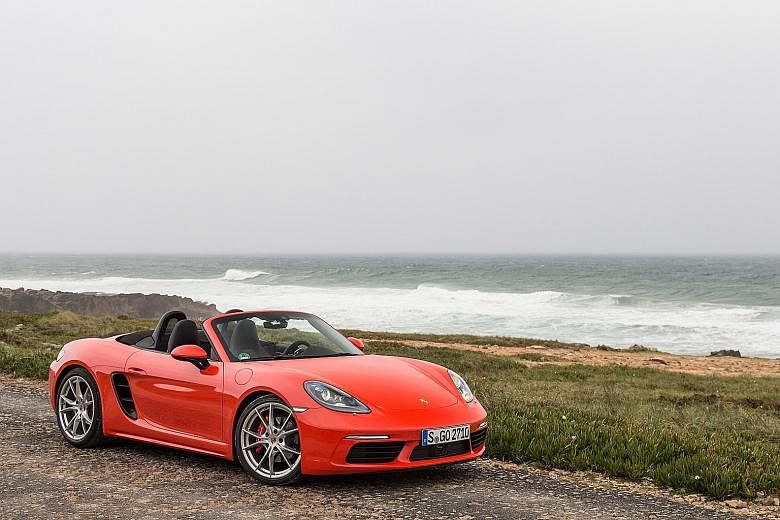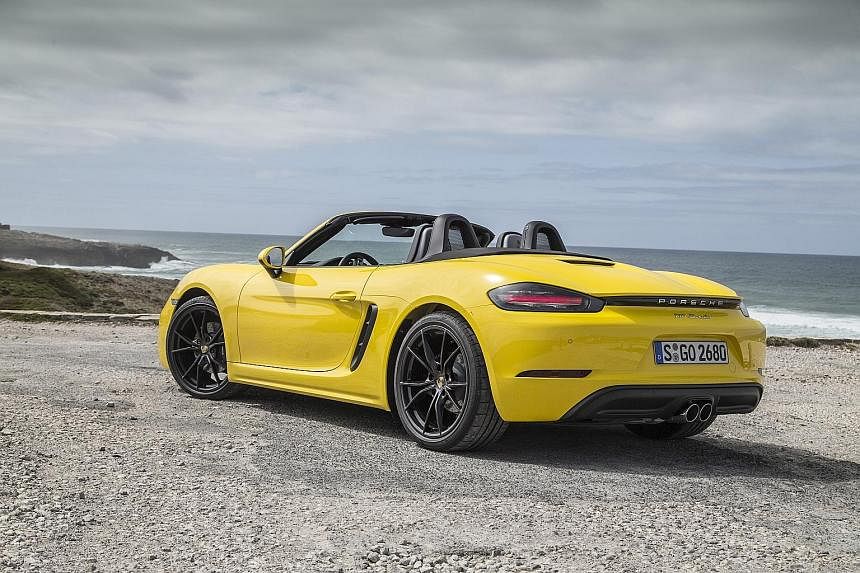Porsche is marking the 20th anniversary of its hugely popular Boxster with a comprehensive mid-term update of the roadster, naming it the 718 Boxster.
That prefix pays homage to the mid-engined 718 sports car which won Porsche many trophies in the late 1950s and early 1960s.
Therein lies a clue to the biggest change in the revised Boxster. Like the old 718, it is now powered by a four-cylinder Boxer engine instead of the six-pot that has driven every Boxster to date.
Engine size is reduced too. The Boxster and Boxster S now use turbocharged 2- and 2.5-litre units respectively, instead of the naturally aspirated 2.7- and 3.4-litre units before.
Despite this, output is up by 35bhp in both cases, to 300bhp and 350bhp respectively. Torque has jumped, with the Boxster gaining 100Nm and the Boxster S 60Nm. It is delivered much earlier and over a wider rev range too.
Performance is markedly improved, with the cars now hitting 100kmh in 4.7 and 4.2 seconds respectively when equipped with the dual-clutch gearbox and optional Sport Chrono pack. Impressively, Porsche says this performance hike goes hand in hand with up to 13 per cent better fuel efficiency.
Visually, the 718 Boxster looks like a sharpened version of its pretty predecessor, but Porsche refuses to use the F word (facelift), describing it instead as a full model change.
-
PORSCHE 718 BOXSTER; BOXSTER S
-
Price: $258,788; $316,588 without COE when it arrives in June
Engine: 1,988cc 16-valve flat-4 turbocharged; 2,497cc 16-valve flat-4 turbocharged
Transmission: Seven-speed dual-clutch with paddle shift
Power: 300bhp; 350bhp at 6,500rpm
Torque: 380Nm at 1,950-4,500rpm; 420Nm at 1,900-4,500rpm
0-100kmh: 4.7; 4.2 seconds (with Sport Chrono)
Top speed: 275kmh; 285kmh
Fuel consumption: 6.9; 7.3 litres/100km
Agent: Stuttgart Auto
It says every body panel is new, save for the bonnet, rear deck, windscreen and folding roof. Look closely and you will spot more pronounced creases in the front wings, rear haunches and doors; the squarer, more aggressive front bumper and the pointier headlamps.
Engines aside, there are other changes under the skin. The steering rack is taken from the 911 Turbo and is 10 per cent quicker than before. There are lateral reinforcements in the rear suspension to raise rigidity and accuracy, and the rear wheels are half an inch wider.
The dampers are new and sturdier and the spring rates changed to reduce roll and pitch. The brakes have been upsized too, with the Boxster using the larger discs of the previous Boxster S and the Boxster S, in turn, adopting those of the current 911.
The upshot of all these is a tremendous sports car. On the Boxster S, pick-up is far stronger than before, especially at low revs, where the car surfs along on its newfound wave of turbo torque.
Power delivery in the non-S Boxster is less torrential, requiring more revs before the car feels seriously fast, but it is still impressive for a mere 2-litre. Both engines are linear, revving keenly and pulling ferociously up to their 7,500rpm redlines.
The engines lack the thrilling top-end wail of the old flat-six, which is a pity. But they still sound good. At idle, there is a barely audible Boxer throb and, on the move, the dominant voice is a deep, purposeful induction note, unless the optional sports exhaust is fitted, in which case you get a raspy song that crackles on the overrun.
The gearboxes are excellent as before - a superbly positive, short-throw change action for the six-speed manual and an instantaneous, whipcrack response on the seven-speed dual clutch.
The Boxster has always been a thrill to drive down a twisty, undulating road and the new one remains so. Steering is delightfully linear and well-weighted and even keener now, thanks to its quicker rack. The nose dives into bends without hesitation or roll, the grip at both ends is astonishing and the car feels agile without sliding unless cornering at insane speeds.
And when the tyres finally do start to go wide progressively, there are no surprises because the chassis remains poised and adjustable, displaying the benefits of its ideal, mid-engined weight balance.
Its race car-like pace and control are coupled with a superb, composed ride. The chassis soaks up everything, even ruts and undulations attacked at speed. On motorways, the car is a superb cruiser, with a well-insulated cabin and relaxed gearing.
Whatever Porsche calls this new car makes no difference. I call it simply brilliant. •The writer is a contributor to Torque, a motoring monthly published by SPH Magazines.


